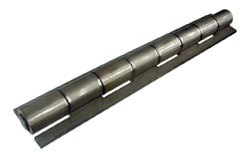
When shopping for hinges, you may come across the terms “light duty” and “heavy duty.” All hinges are mechanical bearings that connect two or more objects while allowing for a limited angle of rotation. They typically feature two leafs that, when interlocked, form a knuckle in the center. Some hinges, however, are light duty, whereas others are heavy duty.
What Are Light-Duty Hinges?
Light-duty hinges are mechanical bearings that support light loads. You can find them in different styles, such as butt, loose joint and weld-on. You can also find them in different sizes and specifications. Regardless, all light-duty hinges are designed for lightweight, low-impact applications.
What Are Heavy-Duty Hinges?
Heavy-duty hinges are mechanical bearings that support heavy loads. They are available in many of the same styles, sizes and specifications as their light-duty counterparts. Heavy-duty hinges are simply stronger and can handle heavier loads.
Differences Between Light-Duty and Heavy-Duty Hinges
There are several differences between light-duty and heavy-duty hinges, one of which is the material from which they are made. Heavy-duty hinges are typically crafted from high-quality stainless steel or aluminum. While some light-duty hinges are made of these same materials, you can also find them in plastic. Plastic hinges are lightweight and inexpensive, but they aren’t able to support heavy loads.
Light-duty and heavy-duty hinges are used in different applications. They are both used to connect two or more objects, and they both allow a limited angle of rotation. Light-duty hinges, though, are designed for use in low-impact applications where they bear less weight than heavy-duty hinges.
Common applications for light-duty hinges include:
- Interior doors
- Cabinets
- Cupboards
- Decorative furniture
- Small gates
- Residential doors
Common applications for heavy-duty hinges include:
- Industrial doors
- Warehouse gates
- Large commercial doors
- Heavy equipment enclosures
- Automotive doors
- Marine parts
Heavy-duty hinges typically have thicker leafs than light-duty hinges. Leafs are the side panels that connect to the objects. With the exception of weld-on hinges, most hinge leafs have a set of holes for threaded fasteners. Heavy-duty hinges have thick leafs that allow them to support heavier loads than light-duty hinges.
In addition to thicker leafs, heavy-duty hinges typically have bigger pins. Pins are metal rods that hold the two leafs together. After interlocking the two leafs together, you can place a pin through the top of the newly formed knuckle. As long as the pin remains in the knuckle, the leafs will stay together. Heavy-duty hinges have a large pin to withstand heavy loads.
In Conclusion
Hinges are often classified as light duty or heavy duty depending on their strength. Heavy-duty hinges are stronger mechanical bearings that can handle more weight. They are typically made of stainless steel or aluminum, and they are designed with thick leafs and large pins.
